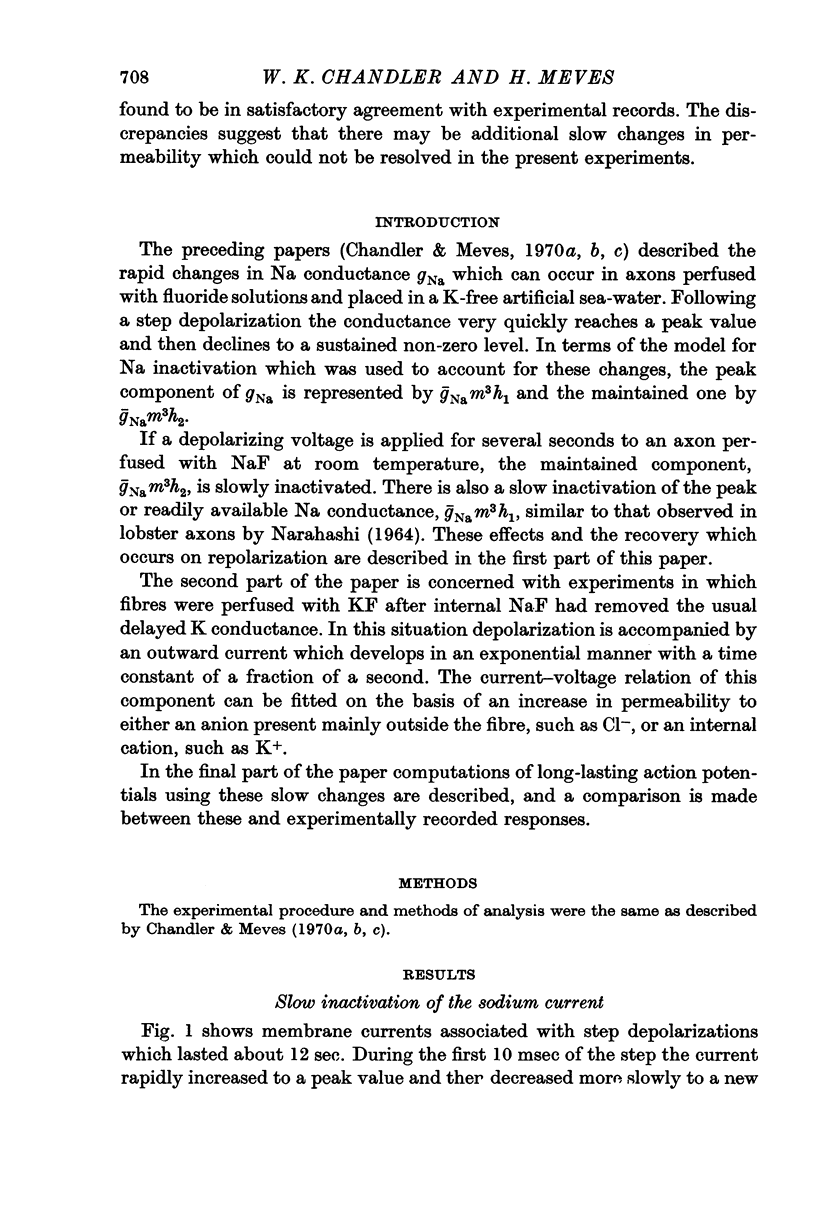Abstract
1. Voltage clamp experiments were carried out on squid giant axons which were perfused internally with 300 mM-NaF + sucrose and placed in K-free artificial sea-water at 16-17° C. On stepwise depolarization (V = -38·5 to 68 mV) the Na conductance gNa rapidly reached a peak value and then declined to a new level; this `maintained' level was slowly inactivated in an exponential manner with a rate constant which varied from 0·3 to 1·1 sec-1. This process was not influenced appreciably by replacing 50 mM-NaF with KF.
2. On repolarization to a potential which varied between -73 and -101 mV the slow inactivation was removed with a rate constant of 0·11-0·73 sec-1.
3. Prolonged depolarization also produced a slow inactivation of the ability of the membrane to give a transient increase in gNa. This effect developed at a rate about ⅓-½ that associated with the inactivation of the `maintained' component; on repolarization, recovery of the peak gNa was 1-2 times as fast as recovery of the `maintained' gNa.
4. In experiments on fibres perfused with 300 mM-KF after internal NaF had removed the usual delayed K conductance, depolarization resulted in an outward current which developed in an exponential manner with a time constant of a fraction of a second. The equilibrium potential for this component was more negative than -50 mV.
5. Long-lasting action potentials were computed on the basis of the above slow changes and, except for the period of final repolarization, were found to be in satisfactory agreement with experimental records. The discrepancies suggest that there may be additional slow changes in permeability which could not be resolved in the present experiments.
Full text
PDF





















Selected References
These references are in PubMed. This may not be the complete list of references from this article.
- Adelman W. J., Jr, Palti Y. The effects of external potassium and long duration voltage conditioning on the amplitude of sodium currents in the giant axon of the squid, Loligo pealei. J Gen Physiol. 1969 Nov;54(5):589–606. doi: 10.1085/jgp.54.5.589. [DOI] [PMC free article] [PubMed] [Google Scholar]
- Adelman W. J., Jr, Palti Y. The influence of external potassium on the inactivation of sodium currents in the giant axon of the squid, Loligo pealei. J Gen Physiol. 1969 Jun;53(6):685–703. doi: 10.1085/jgp.53.6.685. [DOI] [PMC free article] [PubMed] [Google Scholar]
- BAKER P. F., HODGKIN A. L., MEVES H. THE EFFECT OF DILUTING THE INTERNAL SOLUTION ON THE ELECTRICAL PROPERTIES OF A PERFUSED GIANT AXON. J Physiol. 1964 Apr;170:541–560. doi: 10.1113/jphysiol.1964.sp007348. [DOI] [PMC free article] [PubMed] [Google Scholar]
- Chandler W. K., Hodgkin A. L. The effect of internal sodium on the action potential in the presence of different internal anions. J Physiol. 1965 Dec;181(3):594–611. doi: 10.1113/jphysiol.1965.sp007785. [DOI] [PMC free article] [PubMed] [Google Scholar]
- Chandler W. K., Meves H. Evidence for two types of sodium conductance in axons perfused with sodium fluoride solution. J Physiol. 1970 Dec;211(3):653–678. doi: 10.1113/jphysiol.1970.sp009298. [DOI] [PMC free article] [PubMed] [Google Scholar]
- Chandler W. K., Meves H. Rate constants associated with changes in sodium conductance in axons perfused with sodium fluoride. J Physiol. 1970 Dec;211(3):679–705. doi: 10.1113/jphysiol.1970.sp009299. [DOI] [PMC free article] [PubMed] [Google Scholar]
- Chandler W. K., Meves H. Sodium and potassium currents in squid axons perfused with fluoride solutions. J Physiol. 1970 Dec;211(3):623–652. doi: 10.1113/jphysiol.1970.sp009297. [DOI] [PMC free article] [PubMed] [Google Scholar]
- Chandler W. K., Meves H. Voltage clamp experiments on internally perfused giant axons. J Physiol. 1965 Oct;180(4):788–820. doi: 10.1113/jphysiol.1965.sp007732. [DOI] [PMC free article] [PubMed] [Google Scholar]
- FRANKENHAEUSER B., HODGKIN A. L. The after-effects of impulses in the giant nerve fibres of Loligo. J Physiol. 1956 Feb 28;131(2):341–376. doi: 10.1113/jphysiol.1956.sp005467. [DOI] [PMC free article] [PubMed] [Google Scholar]
- Fitzhugh R. Theoretical effect of temperature on threshold in the Hodgkin-Huxley nerve model. J Gen Physiol. 1966 May;49(5):989–1005. doi: 10.1085/jgp.49.5.989. [DOI] [PMC free article] [PubMed] [Google Scholar]
- Goldman D. E. POTENTIAL, IMPEDANCE, AND RECTIFICATION IN MEMBRANES. J Gen Physiol. 1943 Sep 20;27(1):37–60. doi: 10.1085/jgp.27.1.37. [DOI] [PMC free article] [PubMed] [Google Scholar]
- HODGKIN A. L., KATZ B. The effect of sodium ions on the electrical activity of giant axon of the squid. J Physiol. 1949 Mar 1;108(1):37–77. doi: 10.1113/jphysiol.1949.sp004310. [DOI] [PMC free article] [PubMed] [Google Scholar]
- NARAHASHI T. DEPENDENCE OF RESTING AND ACTION POTENTIALS ON INTERNAL POTASSIUM IN PERFUSED SQUID GIANT AXONS. J Physiol. 1963 Nov;169:91–115. doi: 10.1113/jphysiol.1963.sp007243. [DOI] [PMC free article] [PubMed] [Google Scholar]


